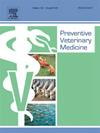Retrospective analysis of submissions to the World Reference Laboratory for foot-and-mouth disease: What can these data tell us about the role of small ruminants in disease epidemiology?
IF 2.2
2区 农林科学
Q1 VETERINARY SCIENCES
引用次数: 0
Abstract
Epidemiological studies can be useful to understand the dynamics of foot-and mouth disease (FMD) virus. Clinical signs of FMD in small ruminants are often difficult to spot, which may lead to an under appreciation of their epidemiological importance in the spread (and therefore control) of FMD. To elucidate the impact of FMD surveillance in small ruminants, retrospective analyses were performed using data collected by the World Reference Laboratory for Foot-and-Mouth Disease. The total number of samples included in these analyses was 32,802, with an average of 444 samples collected per year between 1958 and 2023. When samples were classified into domesticated species groups, the most represented group were Large Ruminant (n = 15021), followed by Small Ruminant (n = 1972), Pigs (n = 1486) and Wildlife (n = 294). Within the domesticated species group, 73.4 % of Pigs and 72.2 % of Large Ruminant samples were FMD virus positive, while Small Ruminant samples had significantly fewer FMD virus positive results (30.0 %). Of the positive samples within the small Ruminant group, serotype O accounted for 86.0 % of the records. These analyses highlight the relative contribution of FMDV positive samples from sheep and goats to global surveillance activities and the potential involvement of small ruminants in maintenance of serotype O. These findings emphasise the importance of these species in control strategies in endemic countries and the necessity to provide specific small ruminant guidelines for FMD diagnostic testing.
对提交给世界口蹄疫参考实验室的资料进行回顾性分析:关于小反刍动物在疾病流行病学中的作用,这些数据能告诉我们什么?
流行病学研究有助于了解口蹄疫病毒的动态。小反刍动物口蹄疫的临床症状通常难以发现,这可能导致对其在口蹄疫传播(从而控制)中的流行病学重要性的认识不足。为了阐明口蹄疫监测对小反刍动物的影响,利用世界口蹄疫参考实验室收集的数据进行了回顾性分析。这些分析中包含的样本总数为32,802,在1958年至2023年期间平均每年收集444个样本。将样本按驯化物种类群分类时,最具代表性的类群是大型反刍动物(n = 15021),其次是小型反刍动物(n = 1972)、猪(n = 1486)和野生动物(n = 294)。在驯化种组中,73.4 %的猪和72.2 %的大型反刍动物样本呈口蹄疫病毒阳性,而小型反刍动物样本的口蹄疫病毒阳性结果明显较少(30.0 %)。在小反刍动物组的阳性样本中,血清O型占86.0 %。这些分析强调了来自绵羊和山羊的口蹄疫病毒阳性样本对全球监测活动的相对贡献,以及小反刍动物在维持o型血清中的潜在作用。这些发现强调了这些物种在流行国家的控制战略中的重要性,以及为口蹄疫诊断检测提供特定的小反刍动物指南的必要性。
本文章由计算机程序翻译,如有差异,请以英文原文为准。
求助全文
约1分钟内获得全文
求助全文
来源期刊

Preventive veterinary medicine
农林科学-兽医学
CiteScore
5.60
自引率
7.70%
发文量
184
审稿时长
3 months
期刊介绍:
Preventive Veterinary Medicine is one of the leading international resources for scientific reports on animal health programs and preventive veterinary medicine. The journal follows the guidelines for standardizing and strengthening the reporting of biomedical research which are available from the CONSORT, MOOSE, PRISMA, REFLECT, STARD, and STROBE statements. The journal focuses on:
Epidemiology of health events relevant to domestic and wild animals;
Economic impacts of epidemic and endemic animal and zoonotic diseases;
Latest methods and approaches in veterinary epidemiology;
Disease and infection control or eradication measures;
The "One Health" concept and the relationships between veterinary medicine, human health, animal-production systems, and the environment;
Development of new techniques in surveillance systems and diagnosis;
Evaluation and control of diseases in animal populations.
 求助内容:
求助内容: 应助结果提醒方式:
应助结果提醒方式:


